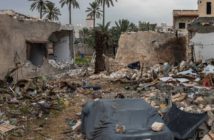Chicago Tribune
Peter Apps, Reuters
LONDON (Reuters) – The chaotic fallout of the “Arab Spring” is fuelling a surge in the smuggling of drugs, weapons and people across the Mediterranean, and cash-strapped regional powers are struggling to respond.
Last month, European leaders in Brussels turned down calls from southern European states already hard hit by the euro-zone crisis for additional support to tackle record numbers of migrants attempting to cross to the continent in frequently perilous journeys arranged by people smugglers.
More than 32,000 migrants from Africa and the Middle East have arrived in Italy and Malta so far this year, the United Nations says. More than 550 died in October alone, as autumn storms made a difficult crossing in small, poorly maintained boats even more dangerous.
At the same time, Syria’s civil war and chaos in Libya are producing massive arms smuggling, while drug runners use similar routes to ship North African hashish and Latin American cocaine.
“You have a perfect storm of money, conflict, instability and illicit supply and demand,” says Masood Karimipour, United Nations Office for Drugs and Crime (UNODC) representative for North Africa and the Middle East. “The migrant issue is the one that is grabbing the headlines, but it’s only a symptom of a much wider regional problem.”
Foreign powers are facing increasing calls to step in, just as the international community was forced to send warships to the Indian Ocean for counter-piracy patrols.
Italy and Malta, the two European countries closest to Libya, have borne the brunt of the migrant crisis and say other European countries should provide much more assistance, perhaps through the European border agency Frontex. The need, they say, is urgent.
After more than 400 migrants died in two separate sinkings south of the island of Lampedusa last month, Italy said it was deploying additional patrol craft, aircraft and drones to track and if necessary rescue approaching migrants.
U.S. forces have responded to several calls for help. In October the U.S. Navy said its assault ship USS San Antonio rescued 121 migrants near Malta after a request from the Maltese government, while the destroyer USS Gravely assisted another migrant vessel in trouble between Greek and Italian waters.
Such arrangements, however, remain almost entirely ad hoc. International cooperation remains limited, and even within countries, the issues of drugs, migrants, arms and counter-terrorism are often handled separately.
“In theory, everyone is in favour of information sharing, but in reality it is not always that easy,” said one Western official on condition of anonymity, contrasting it with the more tightly co-ordinate U.S.-led efforts to stem smuggling in the Caribbean. “The Mediterranean is a lot more complicated.”
SMALL BOATS, SECLUDED INLETS
While the migrant crisis is relatively well documented, reliable data on other smuggling and crime is patchy.
Those who watch the Syrian conflict closely, however – including the growing number of online videos showing weaponry – say smuggling from Libya to Syria has become perhaps the most significant source of rebel arms in the last year. While the Syrian coast remains largely in government hands, weaponry is believed to be slipping in through coastal regions of Lebanon and Turkey.
Using small merchant ships, avoiding major ports and loading and unloading at secluded landing sites sometimes used by smugglers for centuries, such shipments are believed to have been often funded by wealthy Arab individuals.
Heavy machine guns and Russian-built anti-tank aircraft rockets are seen particularly in demand.
“Libya is a largely open market; no arms export licensing, no real customs, coastline effectively out of what passes for government control,” says Hugh Griffiths, illicit trafficking researcher at the Stockholm International Peace Research Institute. “There are plenty of places along the coastline between Turkey and Lebanon where ships can be unloaded.”
SIPRI’s marine trafficking database also shows five major seizures of small Tanzania, Sierra Leone and Comoros-registered cargo ships by France, Spain and Italy in the last six months. Each carried an estimated 20-40 million euros worth of Moroccan hashish.
Such seizures, Griffiths said, were probably the tip of the iceberg.
With Bashar al-Assad’s government preoccupied with its battle for survival, UN coordinator Karimipour said Syria itself had become a major corridor of drugs into the rest of the Middle East. Cocaine shipments, he said, often originated in Latin America before passing through West Africa.
Egyptian authorities have also increased seizures of smuggled weaponry believed to be heading to militants in the Sinai Peninsula, the UNODC says.
“The problems are obviously overlapping,” said UN official Karimipour. “There has been a complete collapse of the security sector in Libya and Syria, and we are seeing both emerging as a major supply routes for drugs and arms to the rest of the Middle East.”
So far, European law enforcement authorities say there is little sign such instability is increasing drug shipments into Europe itself – indeed, Spain has recorded a fall, most likely because of international success against West African smugglers.
But that could change. And some security experts warn that a rise of Somali-type piracy is not impossible.
ONSHORE SOLUTIONS, OFFSHORE COORDINATION
Ultimately, officials say tackling onshore lawlessness will require a concerted effort from both European and North African states, particularly in the most seriously affected countries.
In Libya, the UNODC says it is already working with local authorities to crack down on the criminal networks running smuggling boats, helping build international contacts and tighten local laws.
Western governments are also training local Libyan security forces. In the short term, however, most experts say the prospects for a significant change on the ground in Libya or Syria in particular remain distant.
That may make offshore action more important than ever.
Considerable naval forces already exist in the area. France, Spain and Italy all have large and sophisticated navies with aircraft carriers, submarines, multiple small patrol craft as well as long-range aircraft. The U.S. Sixth Fleet also maintains a constant presence of small and medium-sized warships – as well as the carrier USS Nimitz for much of the last month.
NATO already has its own operation monitoring shipping in the Mediterranean, “Active Endeavour”, formed after the September 11, 2001, attacks to prevent militants from using the sea to mount attacks on Europe. It has boarded 155 ships in 12 years.
The alliance asks all Mediterranean commercial shipping to register with NATO Maritime HQ at Northwood, England, though it says only a fraction do.
Earlier this year, UNODC says a tip-off from Western forces helped Egypt intercept two major drugs shipments. Formally, however, NATO says its mandate does not include liaising with local powers on anything other than terrorism.
That means any NATO unit that wishes to report anything else must do so through its own government rather than NATO channels.
“With Somali piracy, it took several years for the international community to get its act together,” says Eric Thompson, head of strategic studies at The Centre for Naval Analyses, a U.S.-funded body that advises the military. “The same may well turn out to be the case here.”
(Editing by Will Waterman)






